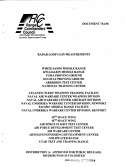No, the source for “+29dB loop gain” improvement for SPY-7.
All I found in your link is that Andy Harrison introduced the term “loop gain”, but not that either Raytheon, Lockheed Martin or the USN use it as such.
From the link I provided, it is clear that the the +20 dB improvement in sensitivity for the 37 RMA SPY-6 is a dimensionless quantity, therefore not the “loop gain”.
I cannot blame you because the term is indeed very obscure. But that doesnt mean it not exist or unused. you only need to search for the term in relevant website and boom..

IF you download the paper you will see it is used by kind of many US testing ranges.

Surely Atlantic Fleet Weapons Training Facility, NAWC, NUWC, Pacific Missile Range is related to USN.
and if you do Practice the methods.. You will find they are correlated. Like this. The 29dB improvements is from calculations using the methods in the book. The real loop gain of the radar in dB is some hundreds of it. This is the Full table i calculated for the AMDR and become the baseline for the SPY-7.

You see, the Baseline Aegis SPY-1 have loop gain of 239 dB.. and the estimated SPY-7 (AMDR with 82 RMA) which i consider it equivalent has Loop Gain of 268 dB.
Simple math : 268-239 = 29 dB of improvement.
Or do you really need me to go step by step ?
So you cannot really say it's dimensionless. It has a dimension, it is a legit merit.
Otherwise i wonder how do you make your conclusion about "100 times more sensitive" ?
Like if you see Radar Range Equation there is part of MDS or "Minimum Detectable Signal" That is your sensitivity and the value is a big NEGATIVE e.g -95 dB or -122 dB. How do you get positive number from there ?



